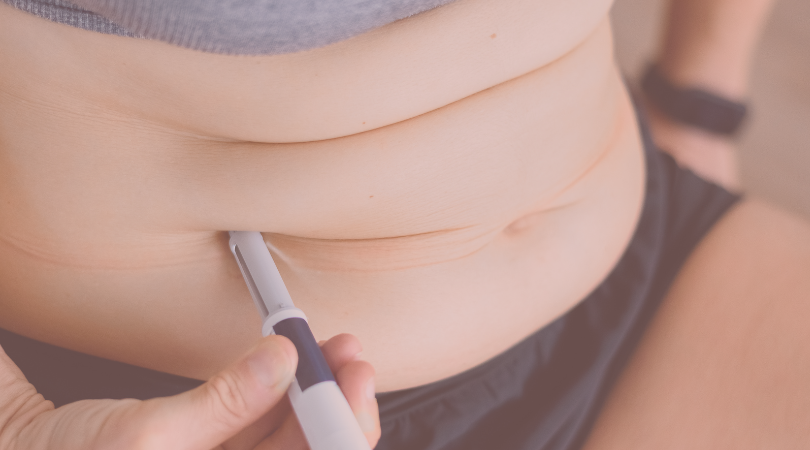You’ve seen Ozempic, Wegovy or Mounjaro all over your feed. You might be curious, cautious, judgmental – or all of the above.
I get it. I coach real women with real lives (jobs, kids, messy kitchens), and I’ve watched these meds help some people… but I’ve also watched the rebound when they stop.
This post is here to give you informed, no-judgement clarity: what GLP-1 weight-loss injections do, why many people regain weight after stopping, what risks to be aware of, and, most importantly, how to build a body that doesn’t need constant firefighting.

What weight-loss injections actually do (in plain English)
GLP-1 (and GLP-1/GIP) medicines help you feel less hungry and full sooner. That usually means eating less and losing weight. If you’ve felt at war with your appetite, this can feel like relief. Totally understandable.
But here’s the catch: when you come off them, your natural hunger hormones (and old patterns) can bounce back. Without a solid plan underneath, weight commonly creeps back – often around two-thirds of what you lost within a year. Why – you’ve never addressed the root issue in the first place. Why is your appetite so all-consuming (genetics, gut health and all sorts plays a role in this)? And how do you eat to support your body?
It’s biology, not failure.
Why regain happens (it’s not a willpower problem)
When you come off a GLP-1 injection like Ozempic or Wegovy, it’s not that you suddenly “lose control” or get lazy.
Your body is simply doing what bodies do best – trying to protect you and keep you alive.
When calorie intake drops for months, your metabolism adjusts. Hunger hormones like ghrelin ramp up, fullness hormones like leptin drop, and your brain starts nudging you to eat more (generally – we are all unique of course). It’s biology.
That’s why studies (like the STEP-1 trial) show that once treatment stops, most people regain around two-thirds of the weight they lost within a year. Appetite rebounds, metabolism slows, and unless you’ve rebuilt your metabolic foundations underneath, the body naturally drifts back to its old “set point.”
Or said another way – you are still yo-yoing back and forth between different weights, which is WORSE for your health than staying at a steady weigh – even if overweight
Sustained results need more than an injection; they require metabolic retraining: maintaining muscle, stabilising insulin response, and rebuilding hunger cues naturally.
So if you’ve regained weight after stopping an injection – you haven’t failed. Your physiology is simply doing its job. The real question is: how do we work with it, not against it?
Or if you are wondering if you will keep the weight off once you stop the medication? It is statistically unlikely.
Risks to know about (so you can choose wisely)
Short-term trials show GLP-1 receptor agonists are generally safe and effective for weight loss, but longer follow-up and real-world data reveal a few concerns worth knowing.
- Gallbladder and biliary disease:
A meta-analysis of 76 RCTs (He et al., 2022, JAMA Internal Medicine) found GLP-1 drugs increased risk of gallstones and biliary disorders, particularly at higher doses and longer use. - Gastro-intestinal effects:
Common side-effects include nausea and constipation; rarer but serious events such as gastroparesis, pancreatitis, and bowel obstruction have been reported in large cohort studies (Sodhi et al., 2023, JAMA IM). - Nutrient depletion:
Chronic appetite suppression can lead to inadequate protein, calcium, vitamin D and fat-soluble vitamins, increasing risk of bone loss or fatigue over time. - Unknown long-term safety:
Most studies extend to roughly two years; data beyond that are limited, especially in non-diabetic populations.
These aren’t reasons to panic, but they are reasons to plan.
If you choose to use a GLP-1, protect yourself by:
- prioritising 30 g protein per meal and strength training to maintain muscle mass;
- monitoring micronutrients and bone density if used >12 months; (AKA the food you do eat needs to be really nutrient dense, rich i vitamins and minerals adn also a multivitamin might be a good idea.)
- addressing the root causes (insulin resistance, inflammation, stress, sleep) alongside treatment. Why have you gained weight? Why are you hungry and constantly thinking about food? These need to be addressed.
Medications can be part of a thoughtful, integrative approach – but they work best when the rest of your biology is supported.
The four foundations I coach every client through
Think of medication as a tool. Tools work best when you’ve built the foundation first. These are the basics I come back to again and again:
1) Insulin management (hello, calmer energy)
Balanced plates (protein + fibre-rich carbs + healthy fats), fewer ultra-processed snacks, and – if you like data – a CGM for 2–4 weeks can be game-changing. Better glycaemic control = steadier appetite and better sleep/mood too.
2) Sleep & stress (your hormones are listening)
Perimenopause + poor sleep = snacky chaos. Create a non-negotiable wind-down, daylight in the morning, and a nervous-system practice you enjoy (yoga, breathwork, tai chi, nature walks).
3) Protein & fibre at every meal
Aim for ~30 g protein per meal and ~30 g fibre per day. Think fish, eggs, Greek yogurt, tofu/tempeh, lentils, quality meats + veg, beans, berries, oats, and seeds (ground linseed, chia, pumpkin). These are your natural “GLP-1-ish” helpers.
4) Know your root causes
Weight is a symptom. Is it insulin resistance, thyroid, perimenopause shifts, meds, gut issues, trauma/stress, nutrient gaps, genetics – or a cocktail? When you know the why, your plan gets simple and strategic. Understand your Root causes today.
If you choose injections – make them part of a plan (not the plan)
- Lay foundations first for 4–6 weeks.
- Lift weights 2–3×/week to protect muscle and metabolism.
- Hit protein targets even when appetite is low (sometimes shakes or Greek yogurt help).
- Replete nutrients via food first; add supplements if needed.
- Create an exit strategy: gradual taper + habits already in place = far better odds of keeping the weight off.
Gentle, natural ways to curb “always hungry” vibes
- Front-load protein at breakfast (25–40 g).
- Add viscous fibres (psyllium, ground linseed) around meals.
- Choose fibre-rich carbs (beans/lentils, oats, fruit, veg) over ultra-processed snacks.
- Keep a daytime eating window of ~10–12 hours; bias calories earlier if you can.
- Move daily and lift something heavy (ish).
SEO sprinkle: protein and fibre for appetite control, insulin resistance and weight loss.
The compassionate bottom line
There’s no shame in wanting help with appetite and weight. Truly. For some, GLP-1s can be a useful bridge. But for most, medication without foundations leads to regain and the endless dieting wagon.
Build your base, understand your body, then decide whether a prescription is a smart tool in your long-term strategy.
I’d love to help you figure out your root causes and a plan that feels doable in real life. Find out more here.
Work with me
- Find your root causes: Book a one-off ROOT session for a personalised, evidence-informed plan → keziahall.com/root
- Get more recipes instantly here







0 Comments